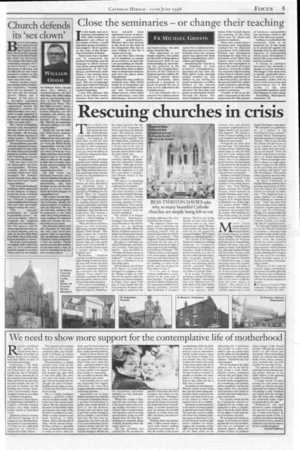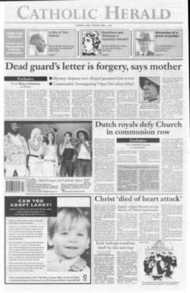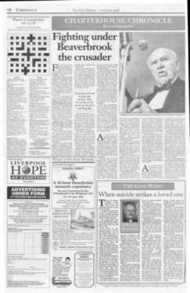Page 5, 12th June 1998
Page 5

Report an error
Noticed an error on this page?If you've noticed an error in this article please click here to report it.
Tags
Share
Related articles
Catholic Closure Fear
Richard Coc Kett
Religious Leaders Call For New Government Strategy Over...
Can We Trust The Dioceses To Preserve Our Heritage?
Victorian Society Condemns Church Closures
Rescuing churches in crisis
T'ENTY-SEVEN City churches threatened with closure are now safe. These churches as you might guess from their number are Anglican. So when their closure was first mooted, a public consultation was held to allow concerned parties a chance to air their views. As a result the Bishop of London has safeguarded them from redundancy.
Imagine, however, that these churches were Catholic (cutting their numbers by three quarters to make the exercise more ardible). What would be the procedure governing their closure? Could you, the parishioner in the pew, stop it?
"If a diocese decides a church can close, the bishop can effectively close it overnight," says Frank Kelsall, Inspector of Buildings for the North West for English heritage, The Anglican church has a long-winded procedure for making disused church property redundant, including a fully public consultation with parishioners, vicar and diocesan authorities. But closing a Catholic church, even one which is a listed building, is relatively straightforward.
"When the diocese decides a church can close, it becomes effectively a secular building." explains Frank Kelsall. "One might expect the Catholic Church to have a similar system to the Anglican Church because they are both parish based. A lot of us would like to see the Catholic Church adopt a system similar to the Anglican one."
Redundant Anglican churches benefit from government funding 70 per cent from the state and 30 per cent from their own resources. Catholic and Non-conformist churches are covered by the Historic Chapels Trust which was intended to parallel the Anglican redundancy fund but does not have the same resources.
The trust is assembling a restoration programme for St Benet's Chapel in Netherton,
but larger projects like the Church of St Augustine in Preston are beyond its financial scope. 'We could not contemplate taking on St Augustine's without lottery support," said Sir Hugh Rossi, chairman of the trust. It would have to find a 70 per cent of the cost of restoration, and this would still leave the church itself to deliver the other 30 per cent.
The Liturgy office is currently drawing up guidelines for redundant Catholic churches. "Although we have far fewer redundant churches than the Anglicans, it is still felt a procedure is needed," said Martin Foster of the Liturgy office.
"We hope to be presenting something to the bishops' conference in November."
But is this too little too late? The latest Buildings at Risk register from English Heritage features two former Catholic churches which were once stunning examples of Victorian architecture. Now, scarcely 10 years after being put on the property market, both are severely vandalised.
The Church of St Francis in Gorton, Manchester, belonged to the order of Franciscan Recollects, who left the parish due to declining numbers, in 1989. When the Bishop of Salford opted not to replace the Franciscans because of the cost of repairs, it was sold to a property developer.
His plans to redevelop the church fell through, and squatters invaded, reducing the church once described as "Probably the finest and most beautiful parish in the north of England" to ruins. A trust is now set to redevelop it as an inter-faith centre.
Like St Francis, the Church of St Mary's in Leeds also belonged to a religious order, the Oblates of Mary. In 1989 they left the church, which has transepts and chancel designed by Pugin. Once again it fell prey to local vandals after the local property developer who had bought it neglected the building, pilfering a few of its artefacts in the process.
The Anglican Church has taken steps to minimise the chance of this happening by retaining control over its churches after they are sold by means of covenant. "The Anglican Church considers any proposals for the uses of a redundant church in the light of what is good for the building," says Dr Rory O'Donnell. "The Catholic system would appear to be more opaque. Apparently there is no such clear system for considering the historic merit of the building, or views of the parish, once the decision has been taken to close it."
It is too easy to blame Catholic indifference to architecture for the sorry state of these churches. "It is glibly said that the Catholic Church does not accept responsibility for its historic churches," protests Mgr McKenna of Liverpool diocese. "But it is a lie. In this diocese we have more listed churches than in any other diocese in the country. We have never pulled one down, and until we do, we cannot be accused of neglect. We've spent millions on maintaining them."
The church of St Francis Xavier in Liverpool is a striking testimony to Liverpool's commitment to retaining its churches. Sited in Everton, north Liverpool, it is one of the city's oldest and most beautiful neogothic churches. Designed by J J Scoles, the church and adjoining school (which educated Bishop Vincent Malone) was built in the 1840s for a Jesuit Order.
In its heyday, 30 priests including at one time Fr Gerald Manley Hopkins -were based there and officiated over 25 daily Masses (for which tickets had to be issued to manage the long queues). Now,
however, this once-densely populated neighbourhood is largely derelict and economically deprived. The church, a Grade II listed building, is in poor condition and needs £1 .5 million for renovations.
Fortunately the story does not end here. The innovative Liverpool Hope University has issued plans to turn the SEX area into a new campus with facilities for fine art, music and drama. Part of its ambitious project involves the restoration of the church for the benefit of parishioners and students, providing jobs and access to education for local people.
However, this kind of money is frankly non-existent in the average Catholic diocese. "The situation is becoming impossible," says Tony Hurley, finance secretary for Cardiff Diocese, which received an English Heritage grant and a Lottery grant to restore the Church of St Francis Xavier in Hereford, one of the register's success stories. "Half a million pounds were needed to restore it, we just don't have the means. Had funding not been forthcoming, we would have to close down the church."
argues that most listed Catholic urches fall into the wrong category to attract ready funding. "Most Catholic listed churches are Victorian and Grade II, the lowest listing. English Heritage only give grants to Grade] and Grade II star, although English Heritage and the Lottery do run a joint scheme for Grade LI churches!'
The old Catholic Cathedral of Middlesbrough, a large decaying inner-city church, typifies the history of many of the churches listed on the register. A new modem Cathedral in the suburbs has replaced the old cathedral, reflecting the shift of the town's Catholics from the town centre to suburbs. The church of St Augustine in Preston unsuccessfully applied for a joint
ARTIN Foster Mch
English Heritage/Lottery grant. 'We submitted an application for £1.7 million to the Heritage/Lottery scheme," explains Simon Thorrington, financial secretary for Lancaster Diocese. "But it was felt that the church sliculd be put to more common use for the money rather than just restoring an old church." Now, the church's main hope for restoration is an urban regeneration plan. "The local borough council is looking at a single regeneration budget for this district at the end of the year and we are working with them," says Mr Thorrington. "You cannot really regenerate the area without including St Augustine's."
Dr Rory O'Donnell of English Heritage believes that a wowing appreciation of Victoriana has helped the Catholic church re-evaluate its buildings: "The Anglicans have a longer tradition of looking at their buildings as 'sermons in stone'. There has been little understanding of the Catholic churches' cultural value in the past," says Dr O'Donnell. "Really, it is outside bodies like the Victorian Society who have drawn the attention of the Catholic Church to its buildings. But it's a gradual process."
In 1994, the Catholic church set up the Historic Churches Committee, a diocesan body to monitor works carried out by parishes on listed churches. Since 1994, the Catholic church has been covered by the ecclesiastic exemption, a legal measure which protects all the Christian churches from secular planning law as long as they are used for worship. When worship ceases at a church, it reverts to state planning controls.
However, if the Catholic Church adapts redundancy procedures hopefully sights like the Victorian ruins of Mount St Mary's and St Francis, Gorton, will then be firmly relegated to the past.
7i) donate to Liverpool Hope University College please contact D Hudson on 0151 291 3434.
blog comments powered by Disqus











